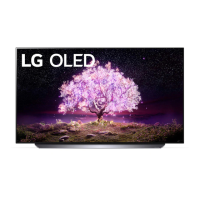
Do you have a question about the LG OLED48C1PUB and is the answer not in the manual?
| Screen Type | oled |
|---|---|
| Color | black |
| Wall Mount | 300mm x 200mm |
| Tuner | digital, atsc, clear qam |
| Screen Size | 48.2 inches, 48 inches |
| Screen Technology | standard oled |
| Resolution | 4k (2160p) |
| Refresh Rate | 120hz |
| Closed Captioning | yes |
| HDR | yes |
| HDR Format | dolby vision, hdr 10, hybrid log-gamma (hlg) |
| Built-In Speakers | true, downward firing |
| Surround Sound | dolby atmos |
| Speakers Output | 40 watts |
| HDMI Ports | 4 |
| HDMI 2.1 Ports | 4 |
| HDMI ARC Ports | yes |
| USB Ports | 3 |
| USB 2.0 Ports | 3 |
| USB 3.0 Ports | 0 |
| Ethernet | yes |
| RF Antenna | yes |
| Bluetooth | true, 5.0 |
| Network | built-in wi-fi, ethernet |
| Headphones Output | yes |
| Digital Optical Audio Outputs | 1 |
| Analog Audio Outputs | 0 |
| Component Video Inputs | 0 |
| Composite Video Inputs | 0 |
| DVI | 0 |
| VGA Ports | 0 |
| SmartTV | webos |
| Streaming Services | hbo max, netflix, prime video, disney+, apple tv+, hulu, paramount+, peacock, youtube tv, spotify, iheartradio |
| Smart Applications | google assistant, amazon alexa, apple homekit |
| Other Devices Connection | mobile to tv |
| Voice Assistant | google assistant, amazon alexa |
| Remote Control | magic, voice control |
| 3D | no |
| Power Consumption | 167 kilowatt hours |
| Depth with Stand | 9.9 inches |
| Height with Stand | 25.6 inches |
| Width with Stand | 42.2 inches |
| Net Weight with Stand | 41.7 pounds |
| Depth without Stand | 1.8 inches |
| Height without Stand | 24.3 inches |
| Net Weight without Stand | 32.8 pounds |
Key safety warnings and precautions for servicing the chassis.
Essential guidelines for safe servicing practices and equipment handling.
Procedures for performing AC leakage current checks for safety.
Standard procedures and precautions to follow during receiver servicing.
Techniques to prevent damage to sensitive electronic components from static electricity.
Guidelines for proper soldering techniques and handling of ES devices.
Defines the TV model's application range and standard testing parameters.
Outlines the testing methodologies and standards applied to the TV.
Provides overall technical specifications including market, broadcasting, and inputs.
Details supported resolutions, frequencies, and pixel clocks for HDMI inputs.
Lists supported resolutions, frequencies, and pixel clocks for DTV inputs.
Instructions for updating the TV software using a USB drive.
Steps for performing software updates via the internet connection.
Managing automatic vs. manual software updates and troubleshooting.
Visual representation of the TV's internal components and their interconnections.
Illustrated breakdown of the TV's parts for identification and replacement.
Step-by-step guide for dismantling the TV unit and its components.
Step-by-step guide for reassembling the TV unit and its components.
Diagnosing and resolving issues related to picture display and video signals.
Steps for identifying and fixing problems related to the TV's power supply.
Procedures for diagnosing and resolving issues with the TV's sound output.
Resolving problems with remote control, Wi-Fi, and other TV functions.
Diagnosing and resolving audio or mechanical noise issues.
Identifying and rectifying external damage to the TV unit.
